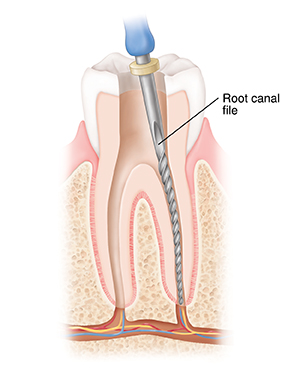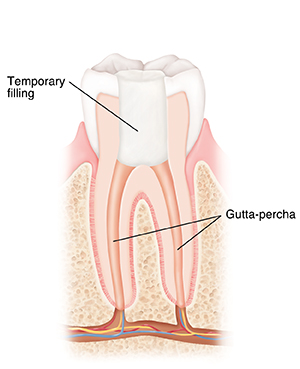A
B
C
D
E
F
G
H
I
J
K
L
M
N
O
P
Q
R
S
T
U
V
W
X
Y
Z
Back to Intro
Click a letter to see a list of medical procedures beginning with that letter.
Click 'Back to Intro' to return to the beginning of this section.
Understanding Root Canal Therapy
Root canal therapy is a way of removing dead or dying tissue from inside a tooth. This stops infection and prevents it from spreading. Therapy is most often completed in 1 to 3 visits. Your dentist will tell you how long each visit is likely to last. Between visits, you’ll need to take special care of the tooth until the part above the gumline (the crown) can be restored.
The first step: cleaning out your tooth
Root canal therapy is done under a local anesthetic. (It’s the same kind of numbing medicine that’s used when you have a filling.)
-
Cleaning and shaping the canal. A thin sheet of rubber (a dental dam) is placed around the tooth. This protects your mouth and throat. The crown of the tooth is then opened. The soft tissue in the middle of the tooth (the pulp) is removed. Using small files, the dentist cleans, enlarges, and shapes the root canal. The root canal is the pathway from the pulp to the jawbone. Medicines may be used to stop infection.
-
Filling the canal. The root canal is filled with a rubberlike substance called gutta-percha. This acts as a permanent bandage. It prevents bacteria or fluid from entering the tooth through the roots. Typically, the opening in the tooth is then closed with a temporary crown or filling.


Between visits
In most cases, the tooth will be closed with a temporary filling. In rare cases, the tooth may be left open for a short time to drain an infection. In either case, pain often can be controlled with over-the-counter medicines. To protect the tooth between visits:
-
Don't eat crunchy, chewy, or sticky foods.
-
Don't chew on the treated side of the mouth unless told you can.
-
Brush and floss as directed.
-
Take antibiotics as prescribed.
The second step: restoring your tooth
After root canal therapy, the crown of the tooth must be restored. In most cases, an artificial crown is needed. Therapy is not complete until a permanent filling is in place—so don’t delay longer than your healthcare provider advises. After restoration, the treated tooth is much like your other teeth.
-
A permanent seal. The dentist removes the temporary filling. A permanent filling is then used to seal the tooth. If needed, an artificial crown is then placed over the remaining tooth. Crowns can be made of ceramic, gold alloy, or porcelain fused to metal.
-
If a post is needed. If little is left of the natural crown, a metal or fiber post may be placed in the root canal to help support the permanent filling. The artificial crown is then placed on top of the filling. Because of heavy chewing forces, molars and premolars should have an artificial crown placed to prevent the tooth from breaking (fracturing).
After treatment is complete
Your dentist will check the tooth during a follow-up visit. With successful treatment, the tooth should function and look very much like your other teeth. You can eat whatever you want, including the hot and cold foods you may have been avoiding. Of course, you’ll need to brush and floss daily to keep your mouth healthy.
When to call your dentist
Call at any stage in the process if any of the following occur:
-
The temporary filling loosens or falls out
-
Part of the tooth breaks
-
Your gums swell
-
Fever of 100.4º F ( 38ºC) or higher, or as directed by your dentist
-
You have pain that can’t be controlled by using over-the-counter medicines
Online Medical Reviewer:
Jessica Gotwals RN BSN MPH
Online Medical Reviewer:
Michael Kapner MD
Online Medical Reviewer:
Rita Sather RN
Date Last Reviewed:
8/1/2022
© 2000-2025 The StayWell Company, LLC. All rights reserved. This information is not intended as a substitute for professional medical care. Always follow your healthcare professional's instructions.